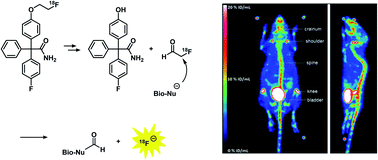Synthesis and biological evaluation of PET tracers designed for imaging of calcium activated potassium channel 3.1 (KCa3.1) channels in vivo†
Abstract
Expression of the Ca2+ activated potassium channel 3.1 (KCa3.1) channel (also known as the Gàrdos channel) is dysregulated in many tumor entities and has predictive power with respect to patient survival. Therefore, a positron emission tomography (PET) tracer targeting this ion channel could serve as a potential diagnostic tool by imaging the KCa3.1 channel in vivo. It was envisaged to synthesize [18F]senicapoc ([18F]1) since senicapoc (1) shows high affinity and excellent selectivity towards the KCa3.1 channels. Because problems occurred during 18F-fluorination, the [18F]fluoroethoxy senicapoc derivative [18F]28 was synthesized to generate an alternative PET tracer targeting the KCa3.1 channel. Inhibition of the KCa3.1 channel by 28 was confirmed by patch clamp experiments. In vitro stability in mouse and human serum was shown for 28. Furthermore, biodistribution experiments in wild type mice were performed. Since [18F]fluoride was detected in vivo after application of [18F]28, an in vitro metabolism study was conducted. A potential degradation route of fluoroethoxy derivatives in vivo was found which in general should be taken into account when designing new PET tracers for different targets with a [18F]fluoroethoxy moiety as well as when using the popular prosthetic group [18F]fluoroethyl tosylate for the alkylation of phenols.



 Please wait while we load your content...
Please wait while we load your content...